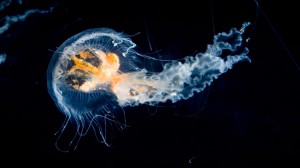Jelly Fish Exhibit in Vancouver Aquarium
 The Jelly Invasion exhibit will run through November 2013 at the Vancouver Aquarium, featuring more than 15 species from around the world.
The Jelly Invasion exhibit will run through November 2013 at the Vancouver Aquarium, featuring more than 15 species from around the world.
The aquarium decided to showcase the stinging invertebrates because they have been making headlines in recent years.
Invasions of jellyfish and jellyfish blooms are happening in areas, and people are curious about where all these jellyfish are coming from.
They have no heart, brain, bones or eyes but some can cause cardiac arrests in humans within minutes of being stung.
B.C. is home to about 75 species of jellyfish, including plenty of moon jellies, which can form huge blooms and have been known to shut down power plants by clogging up water intake pipes in other parts of the world.
In the open ocean lion’s mane jellies can grow to be 60 metres . That guy can get to be about two metres across and have tentacles that string out the length of three school buses. There is got one of the biggest and most famous jellyfishes right here in Vancouver Aquarium.
Humans are spurring the apparent boom in jellyfish populations worldwide, and raising awareness is part of the Aquarium’s motive for hosting the exhibit. Climate change and nutrient-rich agricultural runoff are contributing to the problem.
Fast Facts
Baby Nomura’s jellyfish change from the size of a grain of rice to the size of a washing machine in six months or less.
Jellyfish are 95% water.
Jellyfish aren’t actually fish, they’re invertebrates—animals without backbones.
Jellyfish, the wiggly, pinkish giants can weigh up to 450 pounds (204 kilograms)—as heavy as a male lion—and they’re swarming by the millions.
Some of the most dangerous animals in the world, jellyfish can cause heart attacks in humans within minutes of releasing their sting
